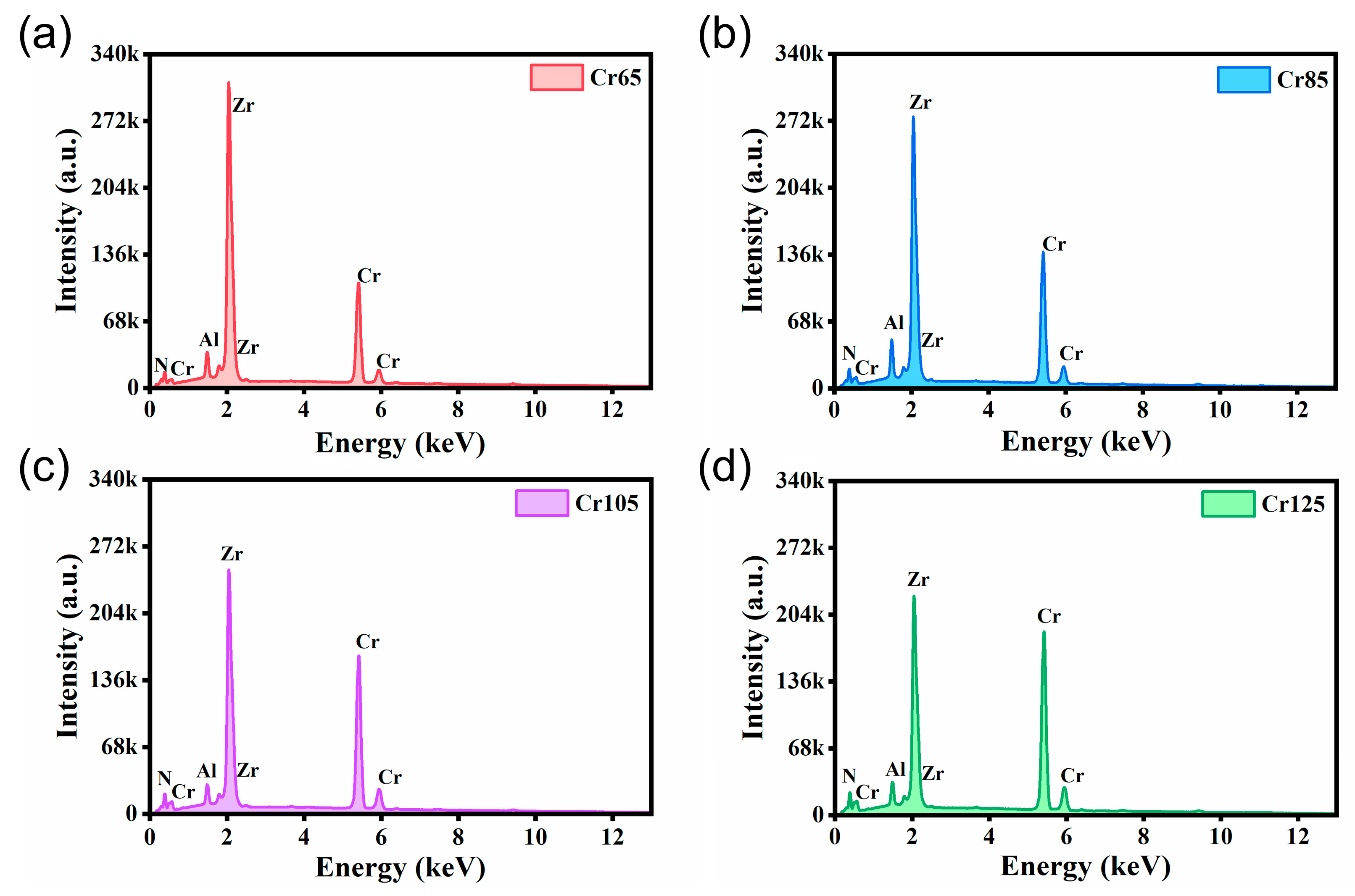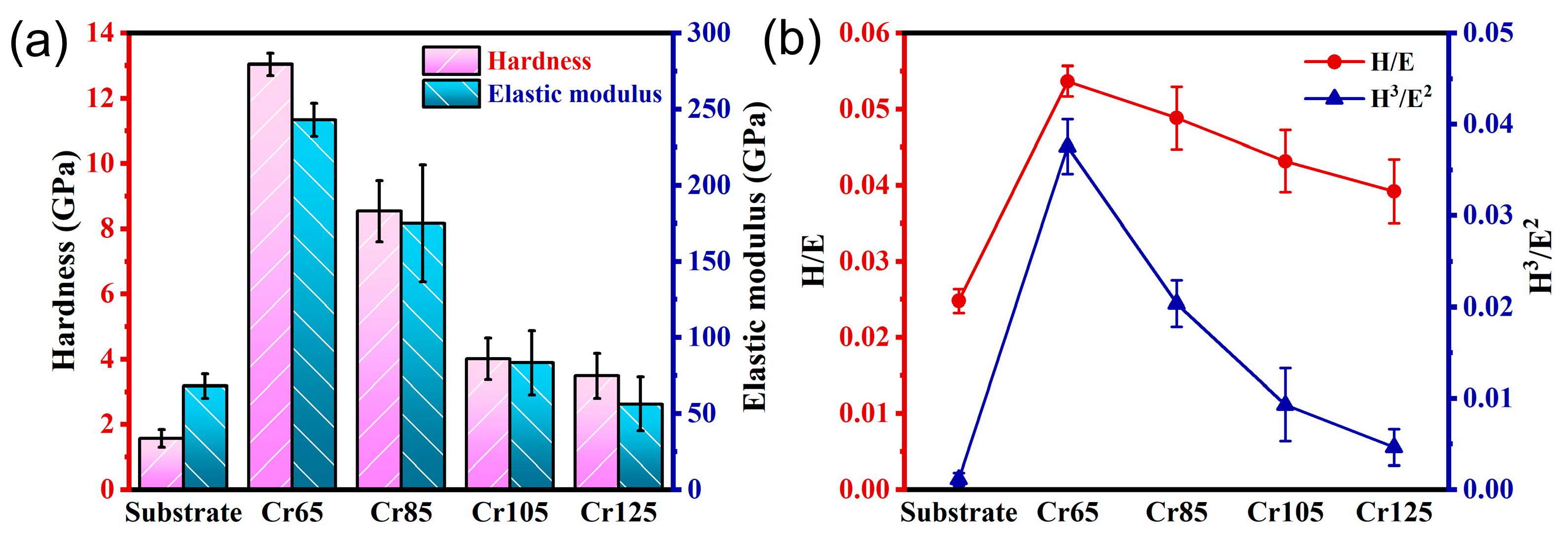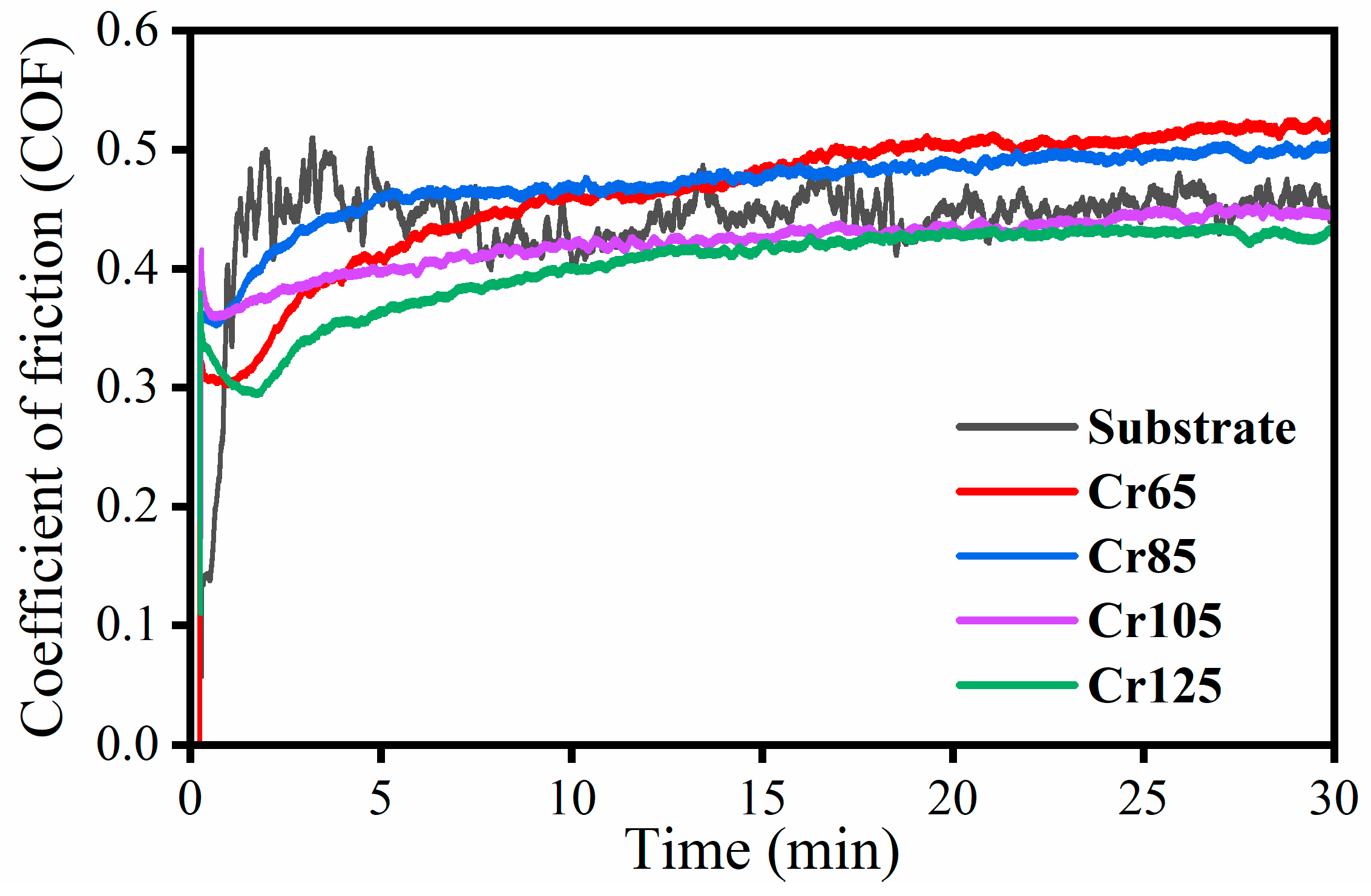The Effect of Cr Cathode Arc Current on the Wear Resistance of Cr/(Zr,Cr)N/(Zr,Cr,Al)N Coatings on 7050 Aluminum Alloy
Abstract
1. Introduction
2. Materials and Methods
2.1. Coating Deposition
- •
- Filtered Cathodic Vacuum Arc Deposition (FCVAD) for Al (purity: 99.5%), aimed at reducing macroparticles and refining grain structure.
- •
- Controlled Accelerated Arc PVD (CAA-PVD) for Zr (99.98%) and Cr (99.99%) targets, enabling precise control of plasma energy and coating structure.
2.2. Applied Testing
3. Results
3.1. Microstructure
3.2. Micro-Mechanical Properties of the Coatings
3.3. The Wear Resistance of Coatings
4. Discussion
5. Conclusions
- (1)
- As the chromium cathode arc current increases, the number and size of micro-particles on the coating surface gradually increase, accompanied by increased surface unevenness and a higher density of crater defects. At 65 A, the coating surface is primarily composed of small spherical particles with diameters less than 3 μm. When the current increases to 85 A, the particle size increases to 3–5 μm, and the coating becomes denser and uniform. However, at higher currents (105 A and 125 A), the micro-particles further coarsen, surface irregularities become more pronounced, elemental distribution becomes more uneven, and the number of craters increases.
- (2)
- All coatings exhibit an NaCl-type B1 structure with the main crystal plane being (111). Changes in Cr doping concentration cause lattice constant variations, leading to low-angle shifts in XRD diffraction peaks, indicating the formation of solid solutions and lattice distortion between Zr and Cr.
- (3)
- Nanoindentation test results show that the hardness of all coatings is significantly higher than that of the uncoated aluminum substrate. The Cr65 sample has the highest hardness (13.03 GPa) and elastic modulus (242.87 GPa), with the optimal H/E and H3/E2 ratios. Coatings deposited under low arc current exhibit high resistance to plastic deformation, while those deposited under high arc current have insufficient hardness and strength.
- (4)
- The Cr125 sample has the lowest COF (approximately 0.42), but its wear volume is relatively large (7.33 × 10−3 mm3). In contrast, the Cr85 sample maintains a low COF (approximately 0.48) while exhibiting the lowest wear volume (9.55 × 10−4 mm3) and a lower wear rate (5.31 × 10−5 mm3/N·m), demonstrating excellent wear resistance. Considering factors such as coating hardness, COF, wear volume, and wear rate, the coating prepared under 85 A conditions exhibits the best wear resistance performance.
Author Contributions
Funding
Institutional Review Board Statement
Informed Consent Statement
Data Availability Statement
Conflicts of Interest
References
- Li, J.; He, T.; Du, X.; Jia, D.; Vereschaka, A. Mechanical properties and microstructure of as-cast AA7050 processed by equal channel angular pressing combined with inter-pass aging treatment. J. Cent. South Univ. 2025, 32, 1678–1696. [Google Scholar] [CrossRef]
- Rometsch, P.A.; Zhang, Y.; Knight, S. Heat treatment of 7xxx series aluminium alloys—Some recent developments. Trans. Nonferrous Met. Soc. China 2014, 24, 2003–2017. [Google Scholar] [CrossRef]
- Li, J.; He, T.; Du, X.; Vereschaka, A. Enhancing the corrosion resistance of high-strength Al-Zn-Mg-Cu alloys after equal channel angular pressing by developing retrogression and re-aging strategies. Corros. Sci. 2025, 246, 112736. [Google Scholar] [CrossRef]
- Zhou, B.; Liu, B.; Zhang, S. The Advancement of 7XXX Series Aluminum Alloys for Aircraft Structures: A Review. Metals 2021, 11, 718. [Google Scholar] [CrossRef]
- Dursun, T.; Soutis, C. Recent developments in advanced aircraft aluminium alloys. Mater. Des. 2014, 56, 862–871. [Google Scholar] [CrossRef]
- Udoye, N.E.; Fayomi, O.S.I.; Inegbenebor, A.O. Assessment of Wear Resistance of Aluminium Alloy in Manufacturing Industry-A Review. Procedia Manuf. 2019, 35, 1383–1386. [Google Scholar] [CrossRef]
- Xu, Y.; Zhang, Z.; Gao, Z.; Bai, Y.; Zhao, P.; Mao, W. Effect of main elements (Zn, Mg and Cu) on the microstructure, castability and mechanical properties of 7xxx series aluminum alloys with Zr and Sc. Mater. Charact. 2021, 182, 111559. [Google Scholar] [CrossRef]
- Zhang, J.; He, T.; Du, X.; Alexer, V.; Song, M.; Chen, X.; Li, J. Effect of pre-heat treatment and subsequent ECAP-CU on microstructure and corrosion behavior of 7075 Al alloy fasteners. J. Cent. South Univ. 2025, 32, 2383–2403. [Google Scholar] [CrossRef]
- Leo, P.; Cerri, E.; De Marco, P.P.; Roven, H.J. Properties and deformation behaviour of severe plastic deformed aluminium alloys. J. Mater. Process. Technol. 2007, 182, 207–214. [Google Scholar] [CrossRef]
- Elhefnawey, M.; Shuai, G.L.; Li, Z.; Nemat-Alla, M.; Zhang, D.T.; Li, L. On dry sliding wear of ECAPed Al-Mg-Zn alloy: Wear rate and coefficient of friction relationship. Alex. Eng. J. 2021, 60, 927–939. [Google Scholar] [CrossRef]
- Yin, X.; Wang, Z.; Yu, H.; Wang, W. Microstructure, aging behavior, and friction and wear properties of ultrafine-grained 7050 aluminum alloy produced by cryogenic temperature extrusion machining. Mater. Today Commun. 2024, 39, 109344. [Google Scholar] [CrossRef]
- Li, Y.; Shi, Y. Microhardness, wear resistance, and corrosion resistance of AlxCrFeCoNiCu high-entropy alloy coatings on aluminum by laser cladding. Opt. Laser Technol. 2021, 134, 106632. [Google Scholar] [CrossRef]
- Grützmacher, P.G.; Suarez, S.; Tolosa, A.; Gachot, C.; Song, G.; Wang, B.; Presser, V.; Mücklich, F.; Anasori, B.; Rosenkranz, A. Superior Wear-Resistance of Ti3C2Tx Multilayer Coatings. ACS Nano 2021, 15, 8216–8224. [Google Scholar] [CrossRef]
- Kameneva, A.; Kichigin, V. Corrosion, wear, and friction behavior of a number of multilayer two-, three- and multicomponent nitride coatings on different substrates, depending on the phase and elemental composition gradient. Appl. Surf. Sci. 2019, 489, 165–174. [Google Scholar] [CrossRef]
- Magnani, M.; Suegama, P.H.; Espallargas, N.; Dosta, S.; Fugivara, C.S.; Guilemany, J.M.; Benedetti, A.V. Influence of HVOF parameters on the corrosion and wear resistance of WC-Co coatings sprayed on AA7050 T7. Surf. Coat. Technol. 2008, 202, 4746–4757. [Google Scholar] [CrossRef]
- Krishnamurthy, N.; Prashanthareddy, M.; Raju, H.; Manohar, H. A study of parameters affecting wear resistance of alumina and yttria stabilized zirconia composite coatings on Al-6061 substrate. Int. Sch. Res. Not. 2012, 2012, 585892. [Google Scholar] [CrossRef]
- Chang, Y.-Y.; Chang, B.-Y.; Chen, C.-S. Effect of CrN addition on the mechanical and tribological performances of multilayered AlTiN/CrN/ZrN hard coatings. Surf. Coat. Technol. 2022, 433, 128107. [Google Scholar] [CrossRef]
- Lewin, E. Multi-component and high-entropy nitride coatings—A promising field in need of a novel approach. J. Appl. Phys. 2020, 127, 160901. [Google Scholar] [CrossRef]
- Franz, R.; Mitterer, C. Vanadium containing self-adaptive low-friction hard coatings for high-temperature applications: A review. Surf. Coat. Technol. 2013, 228, 1–13. [Google Scholar] [CrossRef]
- Voevodin, A.A.; Muratore, C.; Aouadi, S.M. Hard coatings with high temperature adaptive lubrication and contact thermal management: Review. Surf. Coat. Technol. 2014, 257, 247–265. [Google Scholar] [CrossRef]
- Li, W.Z.; Evaristo, M.; Cavaleiro, A. Influence of Al on the microstructure and mechanical properties of Cr–Zr–(Al–)N coatings with low and high Zr content. Surf. Coat. Technol. 2012, 206, 3764–3771. [Google Scholar] [CrossRef]
- Grigoriev, S.; Vereschaka, A.; Uglov, V.; Milovich, F.; Cherenda, N.; Andreev, N.; Migranov, M.; Seleznev, A. Influence of tribological properties of Zr-ZrN-(Zr,Cr,Al)N and Zr-ZrN-(Zr,Mo,Al)N multilayer nanostructured coatings on the cutting properties of coated tools during dry turning of Inconel 718 alloy. Wear 2023, 512–513, 204521. [Google Scholar] [CrossRef]
- Al-Asadi, M.M.; Al-Tameemi, H.A. A review of tribological properties and deposition methods for selected hard protective coatings. Tribol. Int. 2022, 176, 107919. [Google Scholar] [CrossRef]
- Benti, H.G.; Woldeyohannes, A.D.; Yigezu, B.S. Improving the Efficiency of Cutting Tools through Application of Filtered Cathodic Vacuum Arc Deposition Coating Techniques: A Review. Adv. Mater. Sci. Eng. 2022, 2022, 1450805. [Google Scholar] [CrossRef]
- Grigoriev, S.; Vereschaka, A.; Milovich, F.; Sitnikov, N.; Seleznev, A.; Sotova, C.; Bublikov, J. Influence of the yttrium cathode arc current on the yttrium content in the (Ti,Y,Al)N coating and the coating properties. Vacuum 2024, 222, 113028. [Google Scholar] [CrossRef]
- Hee, A.C.; Zhao, Y.; Choudhury, D.; Ghosh, S.; Zhu, Q.; Zhu, H. Tribological behavior of hydrogenated diamond-like carbon on polished alumina substrate with chromium interlayer for biomedical application. Biotribology 2016, 7, 1–10. [Google Scholar] [CrossRef]
- Archard, J. Contact and rubbing of flat surfaces. J. Appl. Phys. 1953, 24, 981–988. [Google Scholar] [CrossRef]
- Warcholinski, B.; Gilewicz, A.; Kuprin, A. Effect of arc current on mechanical properties of AlCrN coatings deposited using cathodic arc evaporation. Vopr. Nauk. Tekhniki 2022, 4, 141–146. [Google Scholar] [CrossRef]
- Wang, B.; Tian, X.; Gong, C.; Geng, H.; Hu, T. Internal cylindrical cathode arc deposited Cr coatings on the interior of slender tube: The influence of arc currents. Vacuum 2025, 232, 113883. [Google Scholar] [CrossRef]
- Grudinin, V.A.; Bleykher, G.A.; Sidelev, D.V.; Yuriev, Y.N.; Lomygin, A.D. Magnetron deposition of chromium nitride coatings using a hot chromium target: Influence of magnetron power on the deposition rate and elemental composition. Surf. Coat. Technol. 2022, 433, 128120. [Google Scholar] [CrossRef]
- Schlögl, M.; Paulitsch, J.; Keckes, J.; Mayrhofer, P.H. Influence of AlN layers on mechanical properties and thermal stability of Cr-based nitride coatings. Thin Solid Film. 2013, 531, 113–118. [Google Scholar] [CrossRef]
- Saunders, N.; Rivlin, V. Thermodynamic characterization of Al–Cr, Al–Zr, and Al–Cr–Zr alloy systems. Mater. Sci. Technol. 1986, 2, 520–527. [Google Scholar] [CrossRef]
- Lamni, R.; Sanjinés, R.; Parlinska-Wojtan, M.; Karimi, A.; Lévy, F. Microstructure and nanohardness properties of Zr–Al–N and Zr–Cr–N thin films. J. Vac. Sci. Technol. A 2005, 23, 593–598. [Google Scholar] [CrossRef]
- Aouadi, S.M.; Maeruf, T.; Twesten, R.D.; Mihut, D.M.; Rohde, S.L. Physical and mechanical properties of chromium zirconium nitride thin films. Surf. Coat. Technol. 2006, 200, 3411–3417. [Google Scholar] [CrossRef]
- Musil, J. Hard nanocomposite coatings: Thermal stability, oxidation resistance and toughness. Surf. Coat. Technol. 2012, 207, 50–65. [Google Scholar] [CrossRef]
- Zhai, W.; Bai, L.; Zhou, R.; Fan, X.; Kang, G.; Liu, Y.; Zhou, K. Recent Progress on Wear-Resistant Materials: Designs, Properties, and Applications. Adv. Sci. 2021, 8, 2003739. [Google Scholar] [CrossRef] [PubMed]
- Franz, R.; Neidhardt, J.; Kaindl, R.; Sartory, B.; Tessadri, R.; Lechthaler, M.; Polcik, P.; Mitterer, C. Influence of phase transition on the tribological performance of arc-evaporated AlCrVN hard coatings. Surf. Coat. Technol. 2009, 203, 1101–1105. [Google Scholar] [CrossRef]
- Leyland, A.; Matthews, A. On the significance of the H/E ratio in wear control: A nanocomposite coating approach to optimised tribological behaviour. Wear 2000, 246, 1–11. [Google Scholar] [CrossRef]
- Maksakova, O.V.; Simoẽs, S.; Pogrebnjak, A.D.; Bondar, O.V.; Kravchenko, Y.O.; Koltunowicz, T.N.; Shaimardanov, Z.K. Multilayered ZrN/CrN coatings with enhanced thermal and mechanical properties. J. Alloys Compd. 2019, 776, 679–690. [Google Scholar] [CrossRef]
- Wang, D.; Lin, S.; Lu, J.; Huang, S.; Yin, Z.; Yang, H.; Bian, P.; Zhang, Y.; Dai, M.; Zhou, K. Research on high temperature wear resistance mechanism of CrN/CrAlN multilayer coatings. Tribol. Int. 2023, 180, 108184. [Google Scholar] [CrossRef]
- Zhang, H.; Liang, Y.; Wang, P.; Shang, X.; Chen, P.; Wu, Y.; Yang, S. One-step construction of CrN coating and Cr-N-Fe metallurgical interface via deposition–nitriding strategy for enhanced fretting wear resistance of 40CrNiMo. Wear 2025, 580–581, 206247. [Google Scholar] [CrossRef]
- Jones, M.R.; Nation, B.L.; Wellington-Johnson, J.A.; Curry, J.F.; Kustas, A.B.; Lu, P.; Chandross, M.; Argibay, N. Evidence of Inverse Hall-Petch Behavior and Low Friction and Wear in High Entropy Alloys. Sci. Rep. 2020, 10, 10151. [Google Scholar] [CrossRef]
- Kumar, A.; Bijwe, J.; Sharma, S. Hard metal nitrides: Role in enhancing the abrasive wear resistance of UHMWPE. Wear 2017, 378-379, 35–42. [Google Scholar] [CrossRef]
- Manikandan, R.; Arjunan, T.V. Studies on micro structural characteristics, mechanical and tribological behaviours of boron carbide and cow dung ash reinforced aluminium (Al 7075) hybrid metal matrix composite. Compos. Part B Eng. 2020, 183, 107668. [Google Scholar] [CrossRef]
- Zhao, Z.; Qu, H.; Bai, P.; Li, J.; Wu, L.; Huo, P. Friction and wear behaviour of Inconel 718 alloy fabricated by selective laser melting after heat treatments. Philos. Mag. Lett. 2018, 98, 547–555. [Google Scholar] [CrossRef]
- Bujak, J.; Walkowicz, J.; Kusiński, J. Influence of the nitrogen pressure on the structure and properties of (Ti,Al)N coatings deposited by cathodic vacuum arc PVD process. Surf. Coat. Technol. 2004, 180–181, 150–157. [Google Scholar] [CrossRef]
- Warcholinski, B.; Gilewicz, A.; Myslinski, P.; Dobruchowska, E.; Murzynski, D.; Kochmanski, P.; Rokosz, K.; Raaen, S. Effect of nitrogen pressure and substrate bias voltage on the properties of Al–Cr–B–N coatings deposited using cathodic arc evaporation. Tribol. Int. 2021, 154, 106744. [Google Scholar] [CrossRef]







| Samples | Elemental Composition [at.%] | |||
|---|---|---|---|---|
| Zr | Cr | Al | N | |
| Cr65 | 23.83 | 24.63 | 3.29 | 48.25 |
| Cr85 | 18.73 | 28.08 | 4.64 | 48.56 |
| Cr105 | 17.08 | 33.19 | 2.21 | 47.52 |
| Cr125 | 14.36 | 35.95 | 2.65 | 47.04 |
| Samples | Wear Volume (mm3) | Wear Rate (mm3/N∙m) |
|---|---|---|
| Substrate | 5.32 × 10−2 | 2.96 × 10−3 |
| Cr65 | 1.54 × 10−3 | 8.55 × 10−5 |
| Cr85 | 9.55 × 10−4 | 5.31 × 10−5 |
| Cr105 | 1.35 × 10−3 | 7.52 × 10−5 |
| Cr125 | 7.33 × 10−3 | 4.08 × 10−5 |
Disclaimer/Publisher’s Note: The statements, opinions and data contained in all publications are solely those of the individual author(s) and contributor(s) and not of MDPI and/or the editor(s). MDPI and/or the editor(s) disclaim responsibility for any injury to people or property resulting from any ideas, methods, instructions or products referred to in the content. |
© 2025 by the authors. Licensee MDPI, Basel, Switzerland. This article is an open access article distributed under the terms and conditions of the Creative Commons Attribution (CC BY) license (https://creativecommons.org/licenses/by/4.0/).
Share and Cite
He, P.; He, T.; Du, X.; Vereschaka, A.; Sotova, C.; Li, J.; Ding, Y.; Chen, K.; Wang, Y. The Effect of Cr Cathode Arc Current on the Wear Resistance of Cr/(Zr,Cr)N/(Zr,Cr,Al)N Coatings on 7050 Aluminum Alloy. Coatings 2025, 15, 1082. https://doi.org/10.3390/coatings15091082
He P, He T, Du X, Vereschaka A, Sotova C, Li J, Ding Y, Chen K, Wang Y. The Effect of Cr Cathode Arc Current on the Wear Resistance of Cr/(Zr,Cr)N/(Zr,Cr,Al)N Coatings on 7050 Aluminum Alloy. Coatings. 2025; 15(9):1082. https://doi.org/10.3390/coatings15091082
Chicago/Turabian StyleHe, Peiyu, Tao He, Xiangyang Du, Alexey Vereschaka, Catherine Sotova, Jian Li, Yang Ding, Kang Chen, and Yuqi Wang. 2025. "The Effect of Cr Cathode Arc Current on the Wear Resistance of Cr/(Zr,Cr)N/(Zr,Cr,Al)N Coatings on 7050 Aluminum Alloy" Coatings 15, no. 9: 1082. https://doi.org/10.3390/coatings15091082
APA StyleHe, P., He, T., Du, X., Vereschaka, A., Sotova, C., Li, J., Ding, Y., Chen, K., & Wang, Y. (2025). The Effect of Cr Cathode Arc Current on the Wear Resistance of Cr/(Zr,Cr)N/(Zr,Cr,Al)N Coatings on 7050 Aluminum Alloy. Coatings, 15(9), 1082. https://doi.org/10.3390/coatings15091082








